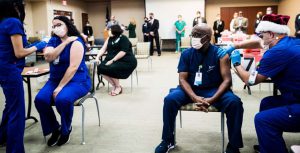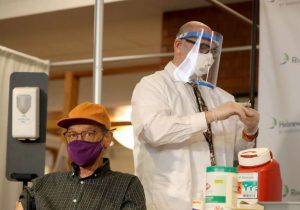DECEMBER 28, 2020

Henry Jackson, right, an employee of Lee Health in the transportation services department is one of the first front line workers for Lee Health to get the COVID-19 vaccine. The vaccine was administered at Lee Health Gulf Coast Medical Center in Fort Myers, Fla. on Tuesday, Dec. 22, 2020. Administering the vaccines is nurse Edson Bezerra. On the left also receiving her vaccine is R.N. Samara Marin. They are receiving the Pfizer vaccine. – Andrew West, The News-Press / USA TODAY Network
Will you get a text from your doctor? Will you read about it online? Or will you have to check the Centers for Disease Control and Prevention website to know when it’s your turn in line?
As COVID-19 vaccines roll out to limited groups of people across the United States, how people learn they are eligible to get their shots won’t be as clear while supplies remain limited, according to public health and policy experts and state vaccination plans.
“I think it’s going to be a little bit murky,” said Katie Greene, a visiting policy associate at the Duke-Margolis Center for Health Policy.
“I wouldn’t be surprised if thousands of individuals get left out because of the information gap,” said Tinglong Dai, a Johns Hopkins Carey Business School professor who studies operations management and business analytics in health care.
Vaccine rollout has largely been left to the states, and with an “isolated and decentralized health system” in the U.S., as Dai put it, people may not know when they’re eligible to get their vaccine. And they may have to be proactive in finding where they can get one and in proving that they meet the criteria to be next in line.
In Phase 1a of the vaccine rollout, health care workers and residents of long-term-care facilities are prioritized, easy groups to reach because they’re in distinct locations, Greene said.
During the next phase, people 75 and older and front-line essential workers should be prioritized, according to recommendations from the CDC’s Advisory Committee on Immunization Practices. After that, Phase 1c will include people 65 to 74 and people 16 to 64 who have high-risk medical conditions, along with other essential workers.
“These are groups that are much harder to reach,” Greene said.
Dai expects there to be some confusion and inefficiency as distribution continues in late winter and early spring, when supply is still growing and more, but not all, people are eligible to get a vaccine.
“It’s going to be a very complicated triage process,” he said, adding that it won’t be consistent across health care providers.
Federal officials with Operation Warp Speed hope that about 50 million people will have received their first of two shots of a COVID-19 vaccine by the end of January, Health and Human Services Secretary Alex Azar said earlier this week.
Two vaccines, one produced by Pfizer and BioNTech and another by Moderna, have already received emergency use authorization from the U.S. Food and Drug Administration. A Phase 3 clinical trial for the Johnson & Johnson vaccine has completed enrollment, and another vaccine candidate from AstraZeneca and Oxford University is expected to follow a few weeks later.
Azar has said the government should have enough supply so that every American who wants a vaccine can get it by summer 2021.
In the middle stages of rollout, state and local public health officials will have a lot of work to do to clearly define and communicate who is eligible, said John Brownstein, chief innovation officer at Boston Children’s Hospital.
“At the state level, there are going to be important nuances in terms of eligibility,” Brownstein said.
“Everyone wants to know their place in line. I think people will be tuned in.”
Preregistration, eligibility websites and emails
The federal government has left it up to states to implement mass vaccination programs. Like many other policy decisions in the pandemic – from testing protocols to restrictions – states will have to tailor their vaccine rollouts to their specific needs, including how they communicate eligibility, Greene said.
State vaccine distribution plans submitted to the CDC earlier this year broadly cover how states will communicate with their residents, and the plans vary on how eligible people will be informed.
Right now, health care workers getting vaccinated find out through their employer, the facilities that are providing the vaccine. CVS and Walgreens are planning to go into tens of thousands of long-term care facilities to provide initial doses to residents and staff.
Many states’ plans say they will rely on traditional media campaigns and mention news conferences from governors, outreach to community groups, and text and email campaigns.
As vaccines become more available, New York’s plan says its residents will also be to check a website for a “vaccine eligibility screening tool and a vaccine administration site locator.”
The health department websites in Colorado and Virginia have trackers that show they’re still in Phase 1a of the rollout.
In Maryland, residents will be able preregister for the vaccine through the state’s existing immunization information system, the state plan says. The department of health will send targeted texts and emails to preregistered patients who have not yet received their vaccine.
Greene said Maryland’s preregistration plan is “a pretty innovative approach” but will rely on how many people can use the system.
Online systems for informing people of eligibility are only as good as the buy-in, Dai said. For example, a hospital may be using a record system, like MyChart, to send alerts to people that they are eligible. But if a patient never set up their MyChart, they may not find out unless they reach out.
“The central problem is we do not have a national waiting list for vaccination, and we do not even have that for individual states or counties,” Dai said, comparing it to the national registry for organ donations.
As rollout expands, the CDC’s playbook on vaccine distribution says it will also develop a screening tool for people to determine their own eligibility. That tool will then point them to VaccineFinder.org, an existing platform that connects the public to information about where they can get seasonal flu vaccines, vaccines for travel and other routinely recommendation vaccines.
Brownstein, who led the development of VaccineFinder.org, said the tool will play an important role in helping people find a vaccine once they learn they’re eligible. He expects COVID-19 vaccine information will be available on the website starting in early 2021.
In November, the Department of Health and Human Services also announced that it would partner with pharmacy chains around the U.S. to provide vaccine as supplies become more available. That partnership is expected to cover 60% of pharmacies throughout the U.S., HHS said.
CVS said in a statement that the public will be able to make appointments to get the vaccine at their pharmacies online or via an 800 number once the vaccine is more widely available.
“We will be promoting availability and raising awareness through multiple channels as we get closer to the timeframe, and dates and prioritization are determined,” Mike DeAngelis, senior director for corporate communications at CVSHealth, told USA TODAY in an email.
‘It’s stuff we’re going to have to figure out in a hurry’
As rollout enters the next phases, some states, however, may lag behind others, complicating the picture of who is eligible at a given time.
Vaccines are allocated according to the number of adults in each state, but that doesn’t mean it will correlate with the number of high-risk people there.
A USA TODAY analysis published this week found which states fare best because they have fewer residents in high-risk categories and which states may lag, still vaccinating health care workers as others move forward to a wider population.
Greene and Brownstein said it’ll be on the state and local public health officials to define who falls into each phase to lessen confusion.
“There will be some gray areas and professions where it’s not clear what group you fit into,” Brownstein said.
Having employers facilitate the process will make those gray areas more straightforward, Greene said, but challenges may persist, especially in smaller work settings with less outreach.
Similar questions could arise as it relates to underlying conditions and comorbidities. Someone’s age is easily verifiable for pharmacies and vaccination clinics, but an underlying condition that puts someone at increased risk for COVID-19 complications may not be, Greene said.
Dai described a scenario where someone has received care in hospital system for an underlying condition but has since moved and plans to get their vaccine from another hospital. If those hospitals use different online records that don’t easily communicate with each other, it could be on the patient to do their own outreach.
“There’s going to have to be some level of expectation of some people not jumping the line,” Brownstein added.
Whether someone would need a doctor’s note to verify their condition would be a requirement that the vaccine provider would have to establish, but Greene said there would be a risk of increasing barriers and accessibility for people who may not have access to a primary care doctor.
“It’s stuff we’re going to have to figure out in a hurry,” she said.
Who gets the vaccine first? Here’s who the CDC recommends.
The CDC’s Advisory Committee on Immunization Practices has recommended that phased vaccine rollout go to the following groups first:
Phase 1a: Front-line health care workers and people in long-term-care facilities.
Phase 1b: People 75 and older and front-line essential workers, in the following categories:
- First responders such as firefighters, police
- Teachers, support staff, day care workers
- Food and agriculture workers
- Manufacturing workers
- Correction workers
- U.S. Postal Service workers
- Public transit workers
- Grocery store workers
Phase 1c: People 65 to 74, people 16 to 64 who have high-risk medical conditions, and other essential workers. The medical conditions listed are:
- Obesity
- Type 2 diabetes
- COPD, or chronic obstructive pulmonary disease
- Heart condition
- Chronic kidney disease
- Immunocompromised state from solid organ transplant
- Sickle cell disease
- Pregnancy
- Smoker (current or with a history of smoking)
Workers in this category include:
- Public health workers
- Transportation and logistics workers
- Food service workers
- Construction workers
- Finance workers
- IT & Communications workers
- Energy workers
- Media workers
- Legal workers
- Public safety engineers
- Water and wastewater workers

Pharmacist Mitchel Zaretsky prepares a COVID-19 vaccine to give to Kelley Dixon, 78, a resident at the Hebrew Home at Riverdale in the Bronx, N.Y. Dec. 21, 2020.
Courtesy/Source: This article originally appeared on USA TODAY






































































































